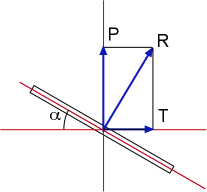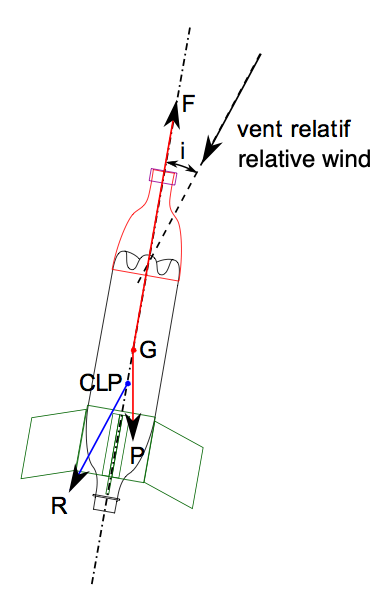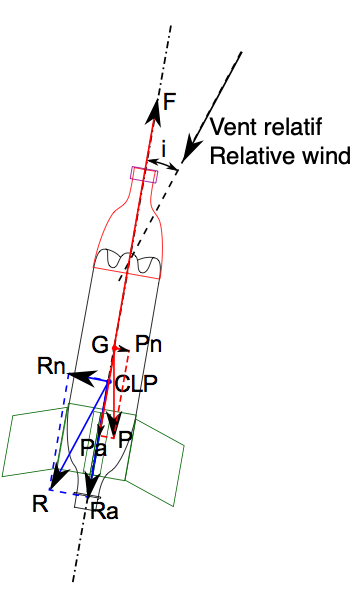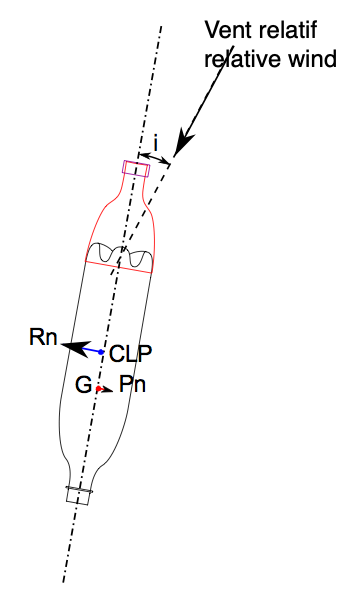Aerodynamics
It is not in my ambitions, nor even, unfortunately, in my skills here to a course on aerodynamics. However, we will see a number of essential concepts for good understanding of the behaviour of a rocket in the air.
For more information, we can, in particular, refer to the article Wikipedia on aerodynamics.
Rockets discussed here are moving in the Earth's atmosphere called the air. The air is a gas (or more specifically a gas mixture) who is compressible, expandable, elastic, viscous and also weighing. All these features have an influence on the movement of solids in air.
Aerodynamics is the study of the behaviour of the air on the body in movement.
The motion of air around an object, or the motion of an object in the air, may be disposed according to two schemes :
- The laminar flow, where all air molecules follow parallel paths. However, the molecules in contact with the body in movement have a speed zero against it, then the layers (or blades) of air, a little more distant will have a higher speed. Finally from a distance from the body in movement, all the layers of air will have the same speed, the airspeed of the air stream. The air layers with a speed lower than the speed of the flow, constitute the boundary layer.
- The turbulent flow, where air molecules are disordered trajectories, while being driven in a global stream with an own speed.
We find these two types of flow in hydrodynamic, there are streams
traBut the airflow diverted will tend to continue their path parallel to
the flow direction, thus creating an air space, "a depression", behind
the plate. But "nature with horror the vacuum", the air molecules (and
the plate also) will be drawn by this depression thereby creating a
turbulent behind the plate. versing little hilly areas and without
obstacles, water flow is laminar, then there are other streams of water
more steep with rocks in their bed and where the water flows more
tormented (torrent), their flow is turbulent.
If now we place the CD cover parallel to the airflow of the fan.
If we now consider a laminar airflow and is placed in the air stream a
flat plate perpendicular to this feed. The experience can be made with a
fan and a CD cover for example.If now we place the CD cover parallel to
the airflow of the fan.

The airflow that arrive on the plate will no longer be able to continue on their way and will have to circumvent this plate. However, these airflow will exert pressure on the plate, experience: to a fan put a CD cover, you feel the force exerted by the pressure of the air on the cover.
But the airflow diverted will tend to continue their path parallel to the flow direction, thus creating an air space, "a depression", behind the plate. But "nature hates vacuum", the air molecules (and the plate also) will be drawn by this depression thereby creating turbulence behind the plate.
we see better the phenomenon in a river, in a portion where the flow is laminar, placing a pebble across the current, it is clear that water comes strike on this rock, creating a rise in the water level front, while behind, to create swirls.
If now we place the CD cover parallel to the airflow of the fan.
![]()
The cover is thin, the airflow will be undisturbed, however we feel that a force tends to remove this cover of the fan. This force is essentially due to the friction of air on the sides of the cover. Indeed, the fact that the air near the walls of the cover layers have different speeds will create forces of viscosity, which can be significant.
All the forces due to these three phenomena (forward pressure, depression on the back and friction) is the drag force.
This drag force is function of :
- air density in kg.m-3
- The surface S that this mobile face airflow, called reference area in m2
- the square of the speed in m.s-1
- The shape of the mobile for which we define a drag coefficient Cx (without dimension)
The drag force is given by :

R is a force, it is expresses in N.
Back on what is called the reference area. It is the orthographic
projection of the mobile on a plane perpendicular to the flow.
In the previous two examples, if you consider that a CD cover is for
size 12 x 12 x 0, 5 cm. When it is perpendicular to the airflow,
reference area is 12 x 12 = 144 cm2, in the second case it
will be 12 x 0.5 = 6 cm2. A rocket of diameter D with 4 fins
size L and e thickness, if it is perfectly in the axis of the airflow,
reference area will be:

Previously, we saw the case of a prepared plate either perpendicular to the airflow, or parallel to the airflow. But what happens, if the plate makes an angle ? with the air flow ?

As in the case of the normal surface, it will occur a phenomenon of overpressure on the surface struck by the air stream and a depression on the surface "in the shelter". On the other hand the plate is also subject to a force of friction. This overpressure, this depression and this friction force will add up to form the air resistance. It should be noted that the resultant force of the depression is about 3 times higher than that due to the pressure and the friction force is generally low before the other two.
This air resistance apply perpendicular to the plate at a point named center of pressure, as it makes an angle ? (called the angle of attack) with the air stream, one can decompose this force in two other forces, one in the axis of the air stream and the other perpendicular.

The T component in the axis of the air stream is opposed to the advancement of the plate, it is the drag force. The P component perpendicular to air flow tends to raise the plate, is the force of lift.
For our water rocket, it should take into account these two forces :
- The drag force will oppose progress, also for maximum performance, it will endeavour to reduce as far as possible that trail. This will be achieved by working the shape of the gear (i.e. the Cx) so that it presents the least possible turbulence generating projections, by limiting as much as possible the reference area (avoid the fins of gigantic and very thick scale) and finally avoiding the rocket take too much angle of attack.
- Lift force will ensure the stability of the rocket in the back parallel to the air stream whenever a disturbance will attempt it deviate.
Now see the behavior of the complete in-flight rocket.
On the rocket, the forces of interest are :
- the thrust (at least initially) engaged in the axis of the rocket and the point of application is located in the centre of gravity or CG.
- the weight exercised vertically and the point of application is also at the center of gravity.l
- the drag which is exercised in the axis of the flow of air around the rocket, which applies in a point called 'center of pressure' or CP.
The sketch below summary this balance of forces.

On this diagram F is the Thrust, R is the drag and P the weight (or mass multiplied by the acceleration due to gravity: m * g). G is the center of gravity of the rocket and CLP is the center of pressure.
We have also indicated the meaning of the "relative wind", which makes an angle with the axis of the rocket i. What is it ?
When the rocket moves in the air, there are two phenomena that comes into play :
- the 'natural' movement of air associated with the weather and so called true wind which is usually horizontal (parallel to the surface of the Earth)
- the moving of the rocket in the air and creates what is called a proper wind (it does not mean that it is free of dirt, but it's the wind of the rocket, so owned). This proper wind is obviously in line with the speed of the rocket.
The combination of these two winds is the relative wind. And it is this relative wind which exerts on the rocket the aerodynamics forces R.So herech, decompose them into axial and normal forces. The axial force is applied along the axis of the rocket and the normal force is applied perpendicular to this axis.
Note right away that the thrust acting on the axis of the rocket, its normal component is zero. We take an interest, so essentially, in two other forces that are the aerodynamics forces R and weight P. The diagram below shows these decompositions.

This opposite figure show that the weight P is decomposed into Pn (normal component) and Pa (axial component), similarly R is decomposed into Rn (normal component) and Ra (axial component). RA is called drag, while Rn is called the lift
The axial components will oppose moving the rocket, while the normal forces will contribute to the stability (or instability) of the rocket, and that's what we'll look more closely now.
To see more clearly, we will forget everything which is useless in this study and keep only the normal forces. This is showed on the figure below :

The angle i that is the axis of the rocket with the relative wind is called the angle of attack. We saw previously that the air resistance was equal to

So for Rn (lift), Cx is called, in the case, lift coefficient Cn and S is the surface of the rocket projected onto a plane perpendicular to the relative wind. It is clear that more the angle of attack will be large and more this surface will be great so Rn will be great.
We also see in the diagram, on the opposite side, that Rn and Pn create a torque that tends to bring the rocket in the axis of the relative wind, i.e. to reduce the angle of incidence. Which means that if a disturbance deflects the rocket of the axis of the relative wind, the lift force acts through the center of pressure to lead the rocket in the right way. Except that, in the diagram above, we are in a good configuration. Indeed, suppose that, for example, the rocket has no fins and its mass is mainly localized in the lower (case of a water rocket during the take-off). Then, the CP will be higher and the centre of gravity lower. What will happen if the rocket departs from its road ?

We see here that the effect of the Rn/Pn couple tends to increase the angle of attack. the rocket will have tendency to stabilize upside down (the front back). But if there is still the thrust, the rocket returns to the ground quickly, so these are very dangerous conditions that should be avoided for the security of peoples and goods.
But go back to our previous cases where the CP is under the G, required condition to have stable rocket.
In practice, if the speed is sufficient, Pn is low before Rn, implying that the center of rotation associated with this couple is close to the centre of gravity. We can therefore consider that the "liveliness" of reaction to an unexpected deviation from trajectory is related to the product of Rn (lift) by the Centre of gravity - Center of pressure distance. This distance divided by the diameter of the rocket is called: static margin.
For a good stability of the water rocket the static margin must be greater than 1.


